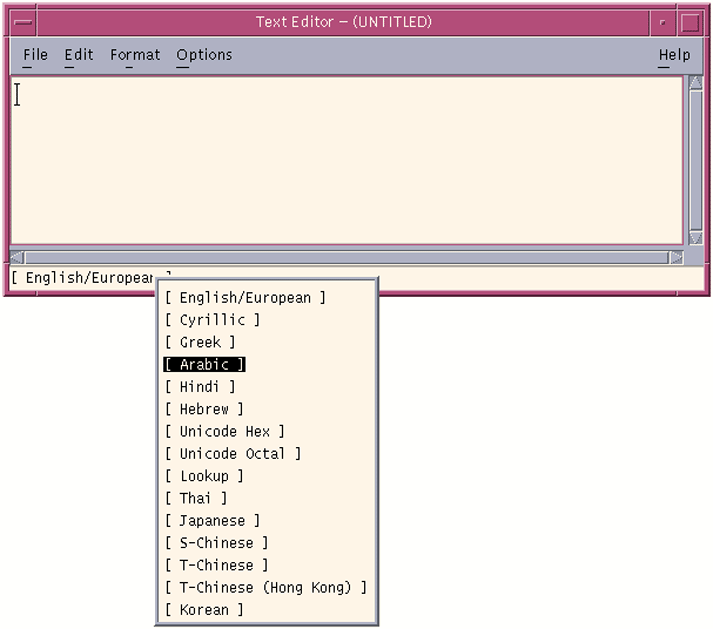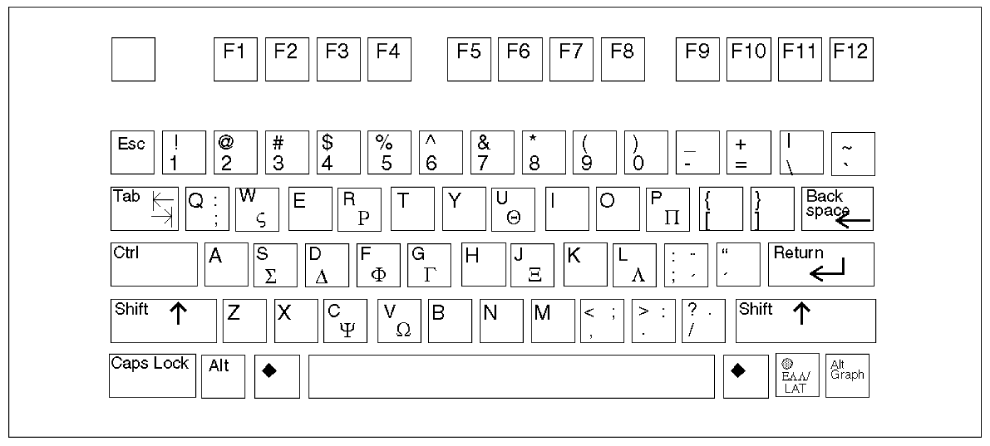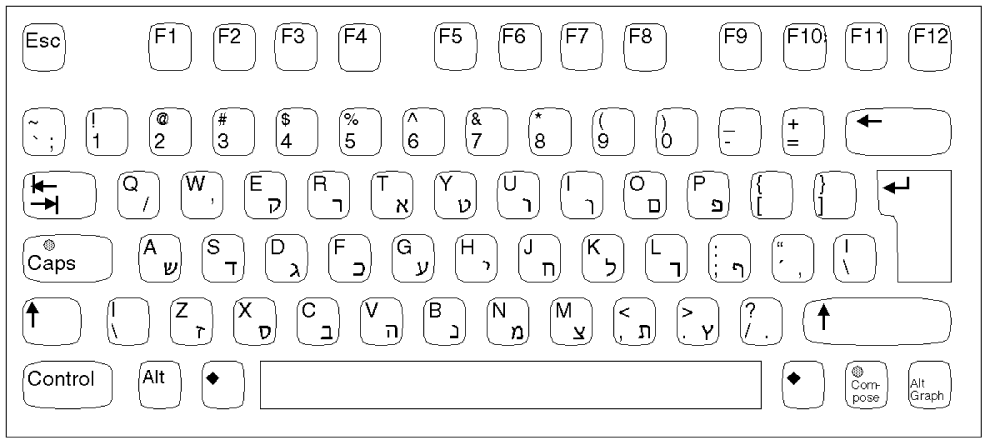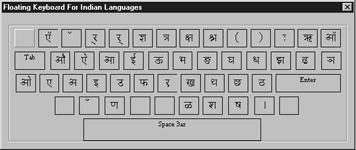Accessing Input Mode
You can switch into a particular input mode by using a Compose key combination or through the input mode selection window. To access the input mode selection window, press mouse button 1 in the status area at the bottom left corner of your application window. The input mode selection window is shown in following figure.
Figure 5–1 Input Mode Selection Window

Input Mode Switch Key Sequences
You can change the current input mode to a new input mode by using the key sequences listed in Table 5–1. The only restriction for using these key sequences is that if you are in one of the Asian input modes, you need to switch back to English/European input mode by pressing Control and spacebar together. Once you are in the English/European input mode, you can switch freely to any other input mode by using the key sequences.
The following key sequences show how to switch to Cyrillic from the English/European input mode:
-
Press the Compose key.
-
Press and release c.
-
Press c.
|
Key Sequences |
Input Mode |
|---|---|
|
Control + Spacebar |
English/European |
|
Compose c c |
Cyrillic |
|
Compose g g |
Greek |
|
Compose a r |
Arabic |
|
Compose h h |
Hebrew |
|
Compose t t |
Thai |
|
Compose h i |
Hindi |
|
Compose j a |
Japanese |
|
Compose k o |
Korean |
|
Compose s c |
Simplified Chinese |
|
Compose t c |
Traditional Chinese |
|
Compose h k |
Traditional Chinese (Hong Kong) |
|
Compose u o |
Unicode octal code input method |
|
Compose u h |
Unicode hexadecimal code input method |
|
Compose l l |
Table lookup input method |
English/European Input Mode
The English/European input mode includes the English alphabet plus characters with diacritical marks (for example, á, è, î, õ, and ü) and characters (such as ¡, §, ¿) from European scripts.
This input mode is the default mode for any application. The input mode is displayed at the bottom left corner of the GUI application window.
To insert characters with diacritical marks or special characters from Latin-1, Latin-2, Latin-4, Latin-5, and Latin-9, you must type a Compose key sequence, as described in the following examples.
To display the Ä character:
-
Press and release the Compose key.
-
Press Shift and A simultaneously. Release Shift and A.
-
Press and release ".
To display the ¿, character:
-
Press and release the Compose key.
-
Press and release ?.
-
Press and release ?.
When there is no Compose key available on your keyboard, you can emulate its operation by simultaneously pressing the Control key and the Shift key.
For the input of the Euro currency symbol (Unicode value U+20AC) from the locale, you can use any one of following input sequences:
-
AltGraph and E together
-
AltGraph and 4 together
-
AltGraph and 5 together
With these input sequences, you press both keys simultaneously. If there is no AltGraph key available on your keyboard, you can substitute the Alt key.
The following tables show the most commonly used compose sequences for Latin-1, Latin-2, Latin-3, Latin-4, Latin-5, and Latin-9 script input for the Solaris operating environment.
The following table lists the common Latin-1 Compose key sequences.
Table 5–2 Common Latin-1 Compose Key Sequences|
Press Compose, then Press and Release |
Then Press and Release |
Result |
|---|---|---|
|
spacebar |
spacebar |
no-break space |
|
s |
1 |
superscripted 1 |
|
s |
2 |
superscripted 2 |
|
s |
3 |
superscripted 3 |
|
! |
! |
inverted exclamation mark |
|
x |
o |
currency symbol ¤ |
|
p |
! |
paragraph symbol ¶ |
|
/ |
u |
mu u |
|
' |
" |
acute accent ´ |
|
, |
, (comma) |
cedilla Ç |
|
" |
" |
diaeresis ¨ |
|
- |
^ |
macron ¯ |
|
o |
o |
degree ° |
|
x |
x |
multiplication sign x |
|
+ |
- |
plus-minus ± |
|
- |
- |
soft hyphen – |
|
- |
: |
division sign ÷ |
|
- |
a |
ordinal (feminine) ª |
|
- |
o |
ordinal (masculine) º |
|
- |
, (comma) |
not sign ¬ |
|
. |
. |
middle dot · |
|
1 |
2 |
vulgar fraction ½ |
|
1 |
4 |
vulgar fraction ¼ |
|
3 |
4 |
vulgar fraction ¾ |
|
< |
< |
left double angle quotation mark « |
|
> |
> |
right double angle quotation mark » |
|
? |
? |
inverted question mark ¿ |
|
A |
` (backquote) |
A grave À |
|
A |
' (single quote) |
A acute Á |
|
A |
* |
A ring above Å |
|
A |
" |
A diaeresis Ä |
|
A |
^ |
A circumflex  |
|
A |
~ |
A tilde à |
|
A |
E |
AE diphthong Æ |
|
C |
, (comma) |
C cedilla Ç |
|
C |
o |
copyright sign © |
|
D |
- |
Capital eth ð |
|
E |
` (backquote) |
E grave È |
|
E |
' |
E acute É |
|
E |
" |
E diaeresis Ë |
|
E |
^ |
E circumflex Ê |
|
I |
` (backquote) |
I grave Ì |
|
I |
' |
I acute Í |
|
I |
" |
I diaeresis Ï |
|
I |
^ |
I circumflex Î |
|
L |
- |
pound sign £ |
|
N |
~ |
N tilde Ñ |
|
O |
` (backquote) |
O grave Ò |
|
O |
' |
O acute Ó |
|
O |
/ |
O slash Ø |
|
O |
" |
O diaeresis Ö |
|
O |
^ |
O circumflex Ô |
|
O |
~ |
O tilde Õ |
|
R |
O |
registered mark ® |
|
T |
H |
Thorn þ |
|
U |
` (backquote) |
U grave Ù |
|
U |
' |
U acute Ú |
|
U |
" |
U diaeresis Ü |
|
U |
^ |
U circumflex Û |
|
Y |
' |
Y acute ý |
|
Y |
- |
yen sign ¥ |
|
a |
` (backquote) |
a grave à |
|
a |
' |
a acute á |
|
a |
* |
a ring above å |
|
a |
" |
a diaeresis ä |
|
a |
~ |
a tilde ã |
|
a |
^ |
a circumflex â |
|
a |
e |
ae diphthong æ |
|
c |
, (comma) |
c cedilla ç |
|
c |
/ |
cent sign ¢ |
|
c |
o |
copyright sign © |
|
d |
- |
eth ð |
|
e |
` (backquote) |
e grave è |
|
e |
' |
e acute é |
|
e |
" |
e diaeresis ë |
|
e |
^ |
e circumflex ê |
|
i |
` (backquote) |
i grave ì |
|
i |
' |
i acute í |
|
i |
" |
i diaeresis ï |
|
i |
^ |
i circumflex î |
|
n |
~ |
n tilde ñ |
|
o |
` (backquote) |
o grave ò |
|
o |
' |
o acute ó |
|
o |
/ |
o slash ø |
|
o |
" |
o diaeresis ö |
|
o |
^ |
o circumflex ô |
|
o |
~ |
o tilde õ |
|
s |
s |
German double s ß also known as sharp S |
|
t |
h |
thorn þ |
|
u |
` (backquote) |
u grave ù |
|
u |
' |
u acute ú |
|
u |
" |
u diaeresis ü |
|
u |
^ |
u circumflex û |
|
y |
' |
y acute y |
|
y |
" |
y diaeresis ÿ |
|
| |
| |
The following table lists the common Latin-2 and Latin-4 Compose key sequences.
Table 5–3 Common Latin-2 Compose Key Sequences|
Press Compose, then Press and Release |
Press and Release |
Result |
|---|---|---|
|
a |
spacebar |
ogonek |
|
u |
spacebar |
breve |
|
v |
spacebar |
caron |
|
" |
spacebar |
double acute |
|
A |
a |
A ogonek |
|
A |
u |
A breve |
|
C |
' |
C acute |
|
C |
v |
C caron |
|
D |
v |
D caron |
|
- |
D |
D stroke |
|
E |
v |
E caron |
|
E |
a |
E ogonek |
|
L |
' |
L acute |
|
L |
- |
L stroke |
|
L |
> |
L caron |
|
N |
' |
N acute |
|
N |
v |
N caron |
|
O |
> |
O double acute |
|
S |
' |
S acute |
|
S |
v |
S caron |
|
S |
, |
S cedilla |
|
R |
' |
R acute |
|
R |
v |
R caron |
|
T |
v |
T caron |
|
T |
, |
T cedilla |
|
U |
* |
U ring above |
|
U |
> |
U double acute |
|
Z |
' |
Z acute |
|
Z |
v |
Z caron |
|
Z |
. |
Z dot above |
|
k |
k |
kra |
|
A |
_ |
A macron |
|
E |
_ |
E macron |
|
E |
. |
E dot above |
|
G |
, |
G cedilla |
|
I |
_ |
I macron |
|
I |
~ |
I tilde |
|
I |
a |
I ogonek |
|
K |
, |
K cedilla |
|
L |
, |
L cedilla |
|
N |
, |
N cedilla |
|
O |
_ |
O macron |
|
R |
, |
R cedilla |
|
T |
| |
T stroke |
|
U |
~ |
U tilde |
|
U |
a |
U ogonek |
|
U |
_ |
U macron |
|
N |
N |
Eng |
|
a |
_ |
a macron |
|
e |
_ |
e macron |
|
e |
. |
e dot above |
|
g |
, |
g cedilla |
|
i |
_ |
i macron |
|
i |
~ |
i tilde |
|
i |
a |
i ogonek |
|
k |
, |
k cedilla |
|
l |
, |
l cedilla |
|
n |
, |
n cedilla |
|
o |
_ |
o macron |
|
r |
, |
r cedilla |
|
t |
| |
t stroke |
|
u |
~ |
u tilde |
|
u |
a |
u ogonek |
|
u |
_ |
u macron |
|
n |
n | |
The following table lists the common Latin-3 Compose key sequences.
Table 5–4 Common Latin-3 Compose Key Sequences|
Press Compose, then Press and Release |
Press and Release |
Result |
|---|---|---|
|
C |
> |
C circumflex |
|
C |
. |
C dot above |
|
G |
> |
G circumflex |
|
G |
. |
G dot above |
|
H |
> |
H circumflex |
|
J |
> |
j circumflex |
|
S |
> |
S circumflex |
|
U |
u |
U breve |
|
c |
> |
c circumflex |
|
c |
. |
c dot above |
|
g |
> |
g circumflex |
|
g |
. |
g dot above |
|
h |
> |
h circumflex |
|
j |
> |
j circumflex |
|
s |
> |
s circumflex |
|
u |
u |
u breve |
The following table lists the common Latin-5 Compose key sequences.
Table 5–5 Common Latin-5 Compose Key Sequences|
Press Compose, then Press and Release |
Press and Release |
Result |
|---|---|---|
|
G |
u |
G breve |
|
I |
. |
I dot above |
|
g |
u |
g breve |
|
i |
. |
The following table lists the Common Latin-9 Compose key sequences.
Table 5–6 Common Latin-9 Compose Key Sequences|
Press Compose, then Press and Release |
Press and Release |
Result |
|---|---|---|
|
o |
e |
Ligature oe |
|
O |
E |
Ligature OE |
|
Y |
" |
Y diaeresis |
Arabic Input Mode
To switch to Arabic input mode, either type Compose a r, or select Arabic from the input mode selection window. For information on accessing the input mode selection window, see Figure 5–1.
The following figure shows the Arabic keyboard layout.
Figure 5–2 Arabic Keyboard

Cyrillic Input Mode
To switch to Cyrillic input mode, either press Compose c c, or select Cyrillic from the Input Mode Selection Window. For information on accessing the input mode selection window, see Figure 5–1.
The Cyrillic (Russian) keyboard layout appears in the following figure.
Figure 5–3 Cyrillic (Russian) Keyboard

After you switch to Cyrillic input mode, you cannot enter English or European text. To switch back to the English/European input mode, type Control and spacebar together, or select English/European input mode from the Input Mode Selection Window by clicking in the status area. See Figure 5–1.
You can also switch into other input modes by typing the corresponding input mode switch key sequence.
Greek Input Mode
To switch to Greek input mode, either press Compose g g, or select Greek, from the input mode selection window. For information on accessing the input mode selection window, see Figure 5–1.
After you switch to Greek input mode, you cannot enter English or European text. To switch back to the English/European input mode, type Control and spacebar together, or select English/European input mode from the Input Mode Selection Window by clicking in the status area. The Greek Euro keyboard layout appears in the following figure.
Figure 5–4 Greek Euro Keyboard

The following figure shows the Greek UNIX keyboard.
Figure 5–5 Greek UNIX Keyboard

Hebrew Input Mode
To switch into Hebrew input mode, either press Compose h h, or select Hebrew from the input mode selection window. For information on accessing the input mode selection window, see Figure 5–1.
The following figure shows the Hebrew keyboard layout.
Figure 5–6 Hebrew Keyboard

Hindi Input Mode
To switch to Hindi input mode, either press Compose h i, or select Hindi from the input mode selection window. For more information on accessing the input mode selection window, see Figure 5–1. To switch back to English/European input mode type Control and spacebar together, or select English/European input mode from the input mode selection window by clicking in the status area.
Figure 5–7 Hindi Keyboard

The keyboard for Hindi-Shift is shown in the following figure.
Figure 5–8 Hindi-Shift Keyboard

Japanese Input Mode
To switch to Japanese input mode, either press Compose j a, or select Japanese from the input mode selection window. For information on accessing the input mode selection window, see Figure 5–1.
To use the native Japanese input system, you need to install one or more of the Japanese locales and reboot the system. After you install the Japanese locale, you can use ATOK12 in all UTF-8 locales. Wnn6 is not available in UTF-8 locales except ja_JP.UTF-8.
Figure 5–9 Japanese Keyboard

Korean Input Mode
To switch to Korean input mode, either press Compose k o, or select Korean from the input mode selection window. For information on accessing the input mode selection window, see Figure 5–1.
To have the native Korean input system, you need to install one or more Korean locales on your system. Once you install the Korean locale, you can use the native Korean input system. For more details on how to use the Korean Input System, refer to Korean Solaris User's Guide.
Figure 5–10 Korean Keyboard

Simplified Chinese Input Mode
To switch to Simplified Chinese input mode, either press Compose s c, or select S-Chinese from the input mode selection window. For information on accessing the input mode selection window, see Figure 5–1.
To use the native Simplified Chinese input system, you need to install one or more Simplified Chinese locales on your system. For more details on how to use Simplified Chinese Input System, refer to Simplified Chinese Solaris User's Guide.
Thai Input Mode
To switch to Thai input mode, either press Compose t t, or select Thai, from the input mode selection window. For information on accessing the input mode selection window, see Figure 5–1.
To switch back to English/European input mode type Control and spacebar together, or select English/European input mode from the input mode selection window by clicking in the status area.
The Thai keyboard layout is shown in the following figure.
Figure 5–11 Thai Keyboard

- © 2010, Oracle Corporation and/or its affiliates
